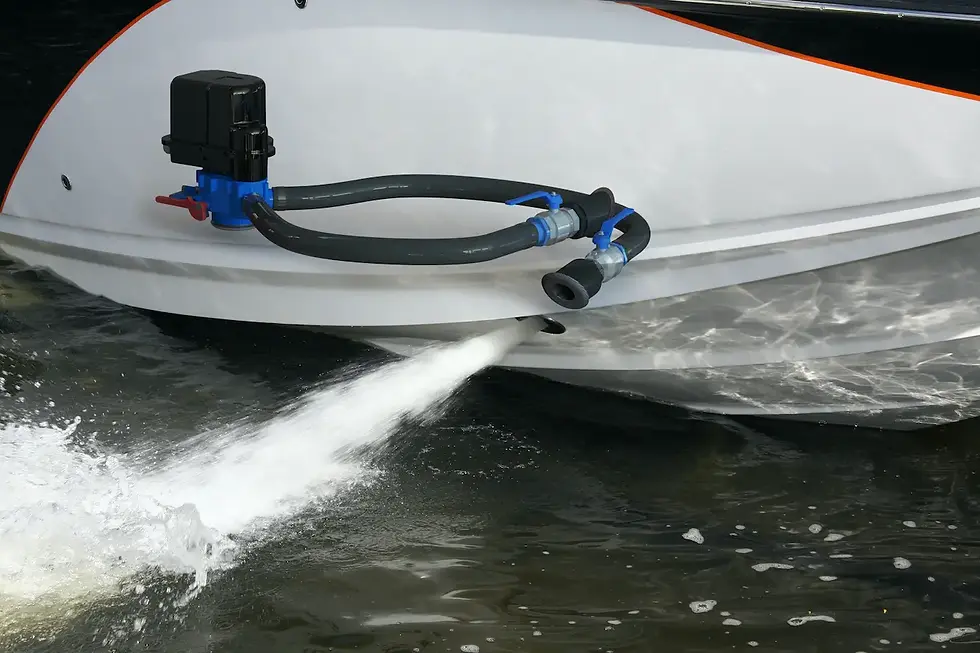What is a Bow Thruster, How Does it Work, and Do I Need One?
- BoatBlurb Contributor

- Sep 2
- 4 min read
Updated: Sep 3
By: Koushik Paul

Ask any boater what keeps them up at night, and the answer usually isn’t running offshore at high speed. It’s docking. Bringing a boat into a tight slip with the wind and current working against you is where most mistakes (and most gel coat scratches) happen. That’s where bow thrusters prove their worth.
A bow thruster is not glamorous. It’s a hidden piece of hardware designed for a single purpose: giving you more control at slow speeds. For decades, they were the domain of commercial vessels and superyachts, but new control systems and falling costs are making them common on mid-sized cruisers and even dayboats.
So what exactly is a bow thruster, how does it work mechanically, and should you consider one for your boat?
What is a Bow Thruster?
A bow thruster is a lateral propulsion device installed in the forward section of a hull. Most are tunnel thrusters: a horizontal tube glassed through the bow with a propeller inside. When engaged, the prop forces water out one side of the hull and draws it in from the other, generating sideways thrust.
By applying that force at the extreme forward end, the entire hull can pivot around its center of gravity. Some vessels add stern thrusters for even more precision, which allows the operator to “walk” the boat sideways in or out of a berth.
External or retractable thrusters also exist, though they are more common on custom builds and retrofits. They trade drag efficiency for installation flexibility.
How Does a Bow Thruster Work?
At its simplest, a bow thruster consists of:
Propulsion unit -- An electric or hydraulic motor drives one or two propellers inside the tunnel. Dual counter-rotating props are increasingly common since they reduce cavitation and improve efficiency.
Tunnel housing -- The tunnel is reinforced to resist impact and minimize drag. Placement is critical: too close to the waterline, and the thruster ventilates in chop; too deep, and installation becomes complex.
Controls -- Typically a joystick at the helm. Modern systems tie into digital networks so the thruster can be managed by the same controls that handle engines, autopilot, and GPS.
When the captain pushes the joystick to port, the thruster propeller pushes water to starboard. Newton’s third law takes care of the rest: the bow swings left. Because the thrust is applied at the far end of the lever arm (the bow), the effect on yaw is magnified, even with relatively modest power output.
Bow thrusters are only effective at low speeds. Above 3–4 knots, water flow past the hull often overwhelms the small jet of thrust. They also draw heavy amperage if electric, so large vessels usually rely on hydraulic or diesel-driven units.
Do I Need One?
On large vessels, bow thrusters are non-negotiable. For example, a large recreational yacht with a tall topside profile will always be at the mercy of windage without one. On smaller boats, the question is more nuanced.
Consider these scenarios:
Tight marinas -- If your home port involves shoehorning into crowded slips, a thruster can prevent expensive mistakes.
Single-handed operation -- Skippers running without crew benefit from the ability to hold the bow while stepping away from the helm to manage lines.
Challenging conditions -- In gusty crosswinds or strong tidal currents, a thruster provides fine control the rudder cannot offer at idle.
If you mostly run small inland lakes with wide-open docks, a thruster might be unnecessary. But, on coastal boats above 30 feet, especially with significant freeboard, they are becoming very common for good reason.
Technology and the Rise of Joystick Piloting
The biggest shift isn’t just thrusters themselves, but how they are integrated. Standalone joysticks are giving way to full systems that combine engines, thrusters, and GPS into one control interface.
Yamaha’s Helm Master EX is one such standout. It blends outboard power, autopilot, GPS, and bow thrusters under a single joystick. Push forward, the boat moves forward. Twist, and it spins. Slide the stick sideways, and the engines and thrusters coordinate to walk the boat to port or starboard.
The Helm Master EX also adds advanced features: StayPoint, which holds position against current and wind; DriftPoint, which allows natural drift while maintaining heading; and FishPoint, which holds location quietly for anglers. The newest upgrade even includes a wireless handheld controller, letting the captain move about the deck while still docking the boat.
What used to be a mechanical safety net is now part of a fully integrated maneuvering system, supported by automation and, increasingly, AI.

Bow thrusters used to be an obscure piece of commercial ship hardware. Today, they are one of the fastest-spreading upgrades in recreational boating. They don’t replace seamanship, but they make docking safer, easier, and less stressful.
With the rise of joystick piloting, they are also stepping into a new role: part of a larger network of smart systems that blend propulsion, GPS, and AI to make boats more intuitive than ever before.
So, do you need one? If you own a large vessel, yes. If you run a smaller boat, it depends on your conditions and comfort level. But as more manufacturers adopt systems like Helm Master EX, bow thrusters are moving from optional luxury to standard equipment.
And the next time you ease into a slip on a windy day without breaking a sweat, you’ll know exactly why they matter. #tips





















Comments